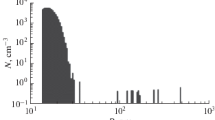Abstract
The results of experimental research into the impact of corona-discharge-generated ions on the evolution of the spectrum of nanometer-size aerosol particles are presented. It is shown that the generation of a corona discharge in the absence of the formed airborne dispersion is accompanied by the spectrum shift of aerosol sizes toward an increase in their average size. It was also shown that the degree of impact of the corona discharge upon the evolution of aerosol spectral composition is mainly determined by local humidity. Furthermore, the generation of a corona discharge is accompanied by the formation of new fine aerosols (less than 3 nm), the concentration of which exceeds the ambient concentration by an order of magnitude (more than 105 1/cm3). The effect of the unipolar corona discharge on the particle spectrum in the aerosol chamber, filled with water aerosol (fog), was elucidated, namely, a decrease in aerosol concentration to the complete disappearance of all aerosols including those in the nanometer range, was observed.
Similar content being viewed by others
References
R. P. Turco, J.-X. Zhao, and F. Yu, “A New Source of Tropospheric Aerosols: Ion-Ion Recombination,” Geophys. Rev. Lett. 25(5), 635–638 (1998).
M. Kulmala, I. Riipinen, T. Nieminen, M. Hulkkonen, L. Sogacheva, H. E. Manninen, P. Paasonen, T. Petaja, M. Dal Maso, P. P. Aalto, A. Viljanen, I. Usoskin, R. Vainio, S. Mirme, A. Mirme, A. Minikin, A. Petzold, U. Horrak, C. Plass-Dulmer, W. Birmili, and V.-M. Kerminen, “Atmospheric Data Over a Solar Cycle: No Connection Between Galactic Cosmic Rays and New Particle Formation,” Atmos. Chem. Phys. 10(4), 1885–1898 (2010).
P. C. Ray, H. Yu, and P. P. Fu, “Toxicity and Environmental Risks of Nanomaterials: Challenges and Future Needs,” J. Environ. Sci. Health, Pt. C, Environ., Carcinog. Ecotoxicol. Rev. 27(1), 1–35 (2009).
A. B. Knol, J. J. de Hartog, H. Boogaard, P. Slottje, J. P. van der Sluijs, E. Lebret, F. R. Cassee, A. Wardekker, J. G. Ayres, P. J. Borm, B. Brunekreef, K. Donaldson, F. Forastiere, S. T. Holgate, W. G. Kreyling, B. Nemery, J. Pekkanen, V. Stone, H-E. Wichmann, G. Hoek, “Expert Elicitation on Ultrafine Particles: Likelihood of Health Effects and Causal Pathways,” Particle and Fibre Toxicol. 6(19), 1–16 (2009).
J. W. Card, D. C. Zeldin, J. C. Bonner, and E. R. Nestmann, “Pulmonary Applications and Toxicity of Engineered Nanoparticles,” Amer. J. Physiol.—Lung Cell. Mol. Physiol. 295(3), L400–L411 (2008).
M. B. Enghoff and H. Svensmark, “The Role of Atmospheric Ions in Aerosol Nucleation—A Review,” Atmos. Chem. Phys. Discuss. 8, 7477–7508 (2008).
R. Hackam and H. Akiyama, “Air Pollution Control by Electrical Discharges,” IEEE Trans. on Dielectrics and Electrical Insulation 7(5), 654–683 (2000).
D. Mariotti and R. M. Sankaran, “Microplasmas for Nanomaterials Synthesis,” J. Phys., D 43(32), 323001–3230022 (2010).
M. Kulmala and V.-M. Kerminen, “On the Formation and Growth of Atmospheric Nanoparticles,” Atmos. Res. 90(2–4), 132–150 (2008).
A. Ankilov, A. Baklanov, M. Colhoun, K.-H. Enderle, J. Gras, Yu. Julanov, D. Kaller, A. Lindner, A. A. Lushnikov, R. Mavliev, F. McGovern, A. Mirme, T. C. O’Connor, J. Podzimek, O. Preining, G. P. Reischl, R. Rudolf, G. J. Sem, W. W. Szymanski, E. Tamm, A. E. Vrtala, P. E. Wagner, W. Winklmayr, and V. Zagaynov, “Intercomparison of Number Concentration Measurements by Various Aerosol Particle Counters,” Atmos. Res. 62(3–4), 177–207 (2002).
E. O. Knutson, “History of Diffusion Batteries in Aerosol Measurements,” Aerosol Sci. and Technol. 31(2), 83–128 (1999).
P. Hvelplund, U. Kadhane, S. B. Nielsen, S. Panja, and K. Stochkel, “On the Formation of Water-Containing Negatively Charged Clusters from Atmospheric Pressure Corona Discharge in Air,” Int. J. Mass Specrometry 292(1–3), 48–52 (2010).
V. B. Lapshin, M. Yu. Yablokov, and A. A. Palei, “Vapor Pressure over a Charged Drop,” Rus. J. Phys. Chem. 76(10), 1727–1729 (2002).
F. Yu, “Modified Kelvin-Thomson Equation Considering Ion-Dipole Interaction: Comparison with Observed Ion-Clustering Enthalpies and Entropies,” J. Chem. Phys. 122(8), 084503 (2005).
V. V. Smirnov, A. V. Savchenko, and V. N. Ivanov, “Modification of Condensation Nuclei under Energy Impacts. 1. Ion-Stimulated Nucleation,” Atmos. Ocean. Opt. 19(5), 356–366 (2006).
Author information
Authors and Affiliations
Additional information
Original Russian Text © V.B. Lapshin, A.A. Paley, A.V. Balyshev, I.A. Boldyrev, S.N. Dubtsov, L.I. Tolpygin, 2012, published in Optica Atmosfery i Okeana.
Rights and permissions
About this article
Cite this article
Lapshin, V.B., Paley, A.A., Balyshev, A.V. et al. Evolution of nanometer-size aerosol in dry and humid environment under the influence of corona discharge. Atmos Ocean Opt 25, 171–175 (2012). https://doi.org/10.1134/S1024856012020108
Received:
Published:
Issue Date:
DOI: https://doi.org/10.1134/S1024856012020108




